A computational study of photonic materials based on Ni bis(dithiolene) fused with benzene, possessing gigantic second hyperpolarizabilities†
Abstract
We propose a family of photonic materials based on nickel bis(dithiolene) [NiBDT] and benzene (B). Linear and planar oligomers of 1D and 2D polymers, together with several rich π-electron linkers (e.g. C14H8, C24H8, and C4O2H4), have been employed in order to demonstrate the superior performance of the proposed materials. A key property for the design of efficient photonic materials is the second hyperpolarizability. We have, thus, computed it together with several other properties, such as the dipole moment, polarizability, first excitation energy, etc. We have also used two indices to estimate the degree of the diradical character of the considered derivatives. The calculations have been performed by employing density functional theory. Considerable care has been taken to validate the computational procedure we have used. The main findings of the present work are as follows: (a) the 1D and 2D coordination polymers based on nickel bis(dithiolene) and benzene and in particular the linear ones, (B-NiBDT)n, are very likely to be efficient photonic materials, since they have gigantic second hyperpolarizability. (b) The second hyperpolarizability greatly depends on the organic linker with which NiBDT is fused and on the structure; for example, the linear oligomers have much higher second hyperpolarizability than the planar ones. The present work together with a recent article (A. Avramopoulos et al., J. Phys. Chem. C, 2016, 120, 9419–9435) demonstrates a mechanism for designing efficient photonic materials.



 Please wait while we load your content...
Please wait while we load your content...